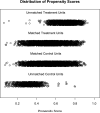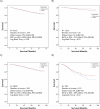Association of sentinel lymph node biopsy with survival for head and neck melanoma: survival analysis using the SEER database
- PMID: 25321889
- PMCID: PMC4294459
- DOI: 10.1001/jamaoto.2014.2530
Association of sentinel lymph node biopsy with survival for head and neck melanoma: survival analysis using the SEER database
Abstract
Importance: Sentinel lymph node biopsy (SLNB) provides prognostic information for melanoma; however, a survival benefit has not been demonstrated.
Objective: To assess the association of SLNB with survival for melanoma arising in head and neck subsites (HNM).
Design, setting, and participants: Propensity score-matched retrospective cohort study using the Surveillance Epidemiology and End Results (SEER) database to compare US patients with HNM meeting current recommendations for SLNB, treated from 2004 to 2011 with either (1) SLNB with or without neck dissection, or (2) no SLNB or neck dissection.
Interventions: SLNB with or without neck dissection.
Main outcomes and measures: Disease-specific survival (DSS) estimates based on the Kaplan-Meier method, and Cox proportional hazards modeling to compare survival outcomes between matched pair cohorts.
Results: A total of 7266 patients with HNM meeting study criteria were identified from the SEER database. Matching of treatment cohorts was performed using propensity scores modeled on 10 covariates known to be associated with SLNB treatment or melanoma survival. Cohorts were stratified by tumor thickness (thin, >0.75-1.00 mm Breslow thickness; intermediate, >1.00-4.00 mm; and thick, >4.00 mm) and exactly matched within 5 age categories. In the intermediate-thickness cohort, 2808 patients with HNM were matched and balanced by propensity score for SLNB treatment; the 5-year DSS estimate for those treated by SLNB was 89% vs 88% for nodal observation (log-rank P = .30). The hazard ratio for melanoma-specific death was 0.87 for those undergoing SLNB (95% CI, 0.66-1.14; P = .31). In each of the other cohorts analyzed, including those with thin and thick melanomas, and cohorts with melanoma overall, no significant difference in DSS was demonstrated.
Conclusions and relevance: This SEER cohort analysis demonstrates no significant association between SLNB and improved disease-specific survival for patients with HNM.
Figures




References
-
- Jemal A, Siegel R, Xu J, Ward E. Cancer Statistics, 2010. CA: A Cancer Journal for Clinicians. 2010;60(5):277–300. doi:10.3322/caac.20073. - PubMed
-
- Morton DL, Wen DR, Wong JH. Technical details of intraoperative lymphatic mapping for early stage melanoma. Archives of Surgery. 1992;(127):392–399. - PubMed
-
- Gershenwald JE, Thompson W, Mansfield PF, et al. Multi-institutional melanoma lymphatic mapping experience: the prognostic value of sentinel lymph node status in 612 stage I or II melanoma patients. Journal of Clinical Oncology. 1999;17(3):976–976. - PubMed
MeSH terms
Grants and funding
LinkOut - more resources
Full Text Sources
Other Literature Sources
Medical

